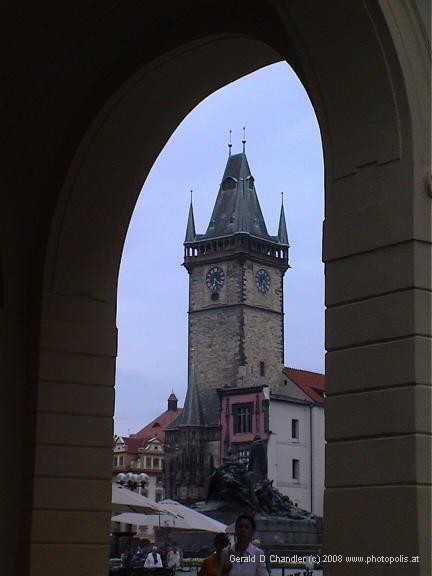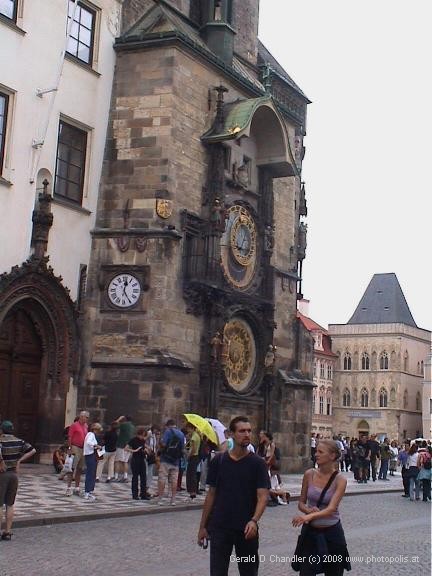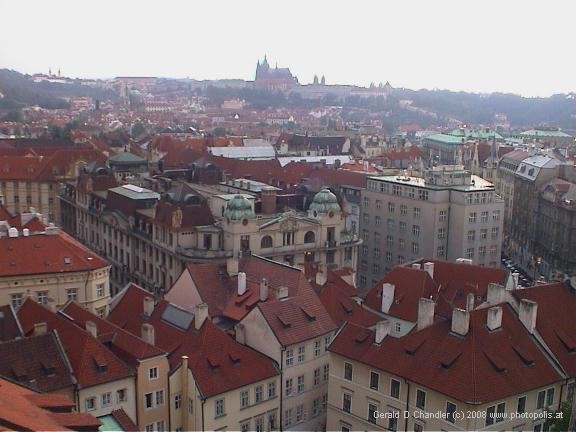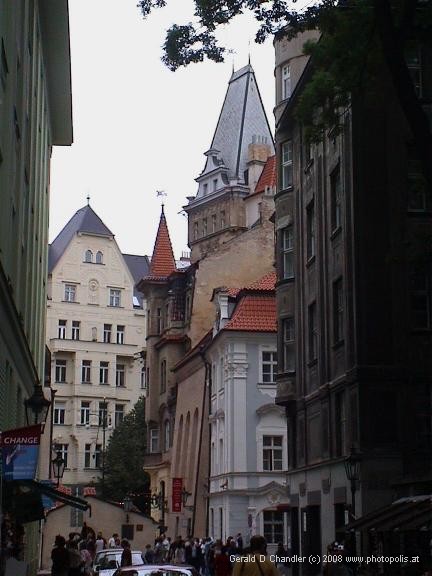Home | Front Page | Index | Blog | New | Contact | Site Map
Prague Intro
Old Town
Charles Bridge
Castle Hill
Josephov
North-East
Wenceslas Square
Vysehrad
Vltava
Foto Show

Egypt
Israel
Turkey
Bulgaria
Romania
Ukraine
Poland
Prague
Britain
USA 2002
Travel Map

Statue of John Huss (Jana Husa) in Main Square |

North side of Old Town Square. |
Prague has a lot of similarities with other north-central European towns, such as Wroclaw, Krakow, and Lviv. All of them had central market squares (Rynok or Rynak) which were the center of economic and political life in the Middle Ages. Old Town Square played such a role for Prague. Today it is still the center of Old Town but the commerce is more ersatz: merchants operate kiosks throughout the square, selling souvenirs and sweets.
One of the most famous and familiar sights in the Old Town Square is the statue of John Huss (1372?-1415). He was a Bohemian religious reformer whose ideas anticipated the protestant reformation by about 100 years. Unlike Martin Luther, John Huss was rounded up and burned at the stake (in 1415) before his movement could take off. As he was Czech, it is worth knowing his name in that language: Jana Husa (also Jan Hus).
All around the square (and in its middle) are buildings of historic note, some quite beautiful. On the north side of the square are Goltz-Kinsky Palace, House of the Stone Bell,and the Tyn Church. The right photo catches a corner of the Goltz-Kinsky Palace. A bit to the right,with a mansard roof, is the House of the Stone Bell. Further right, and by far the largest, in the center of the north side,is Tyn Church. Be sure to go in, perhaps just before going up the Clock Tower.

Old Town Clock Tower
|

Clock Tower Face
|
Even better known and more memorable than the John Huss statue is the Clock Tower with its elaborate clock on the lower face and simpler clocks higher up. You should be sure to see one of the hourly performances of the lower clock; you'll certainly not be alone as tourists flock there. We missed it twice by a few minutes before we finally got back to the square "on time."
This giant clock is the antithesis of today's microprocessor clock. Mechanical clocks were first built in the fourteenth century and had to be big because the technology (i.e. precision pieces) was not there to make them smaller. Just as vacuum tubes gave way to smaller single transistors and then to integrated circuits, over about three centuries clocks were refined until they became pocket and then wrist watches.
But long before that happend, in about 1410 the Prague clock (or Horloj or Orlog, to give it a middle ages name) was built. Moving figures were added in 1490. Starting then, and continuing to today (with a long interruption when the clock was damaged), on the hour the twelve Christian apostles appear in the window above the clock face. The clock also tracks the movement of the sun and moon through the zodiac. (Incidentally, in Josephov on the Old-New synagogue there is another distinctive clock: its numerials are Hebrew letters, and since Hebrew is read right-to-left, the clock goes what we normally call anti-clockwise!)

View of Old Town and (across hidden Vltava River) Castle and Cathedral |
From the top of the clock tower (admission must be paid and you must arrive when it is open) it seems as if the whole world can be seen. Of course you can look down and see the Tyn Church, St Nicolas Church, and the John Huss statue. And the crowd. On a cold day in December or January there may not be many people. But on a warm spring or summer day, or on a fine evening the square will be overflowing with people.
But look farther. If you look to the west you will see, beyond the broad but hidden Vltava, the Lesser Quarter and Prague Castle. It sits there looking rather small. But later when you approach you will learn how big it is.

St Nicolas's Church on north Old Town Square
|

Narrow street in Old Town
|
Having come down from the Clock tower, head for Charles Bridge (Most Karly). Before you do so, perhaps take another look around the square, and if time allows, take a moment to go into St Nicolas's Church on the north side of the square. Then walk along one of the narrow streets that lead to the river and bridge. There are a few choices — the paths diverge and then merge, but if you keep in mind that you are going west, and keep going west, you easily get there. Or just ask. Everybody about is a tourist and almost certainly speaks English.